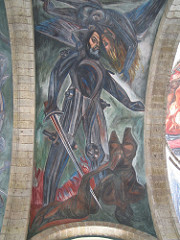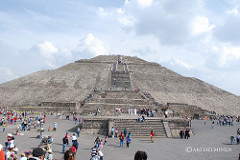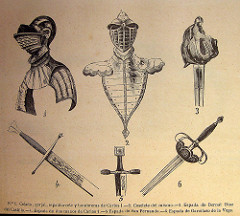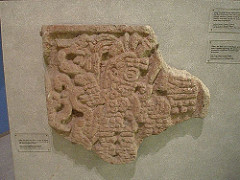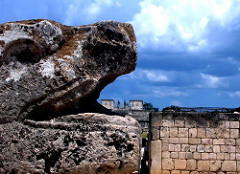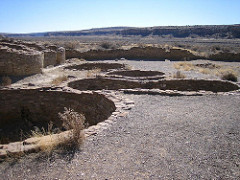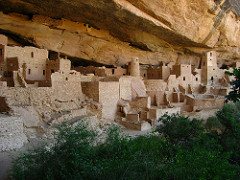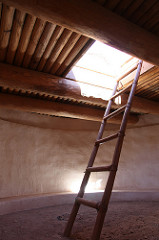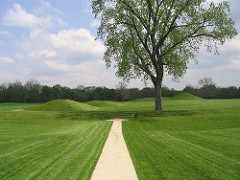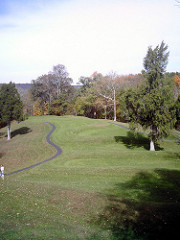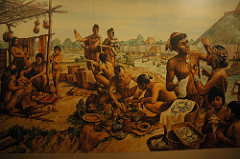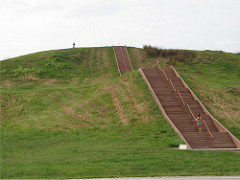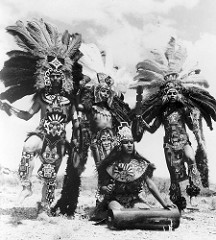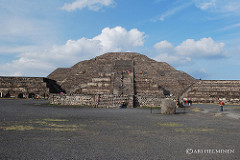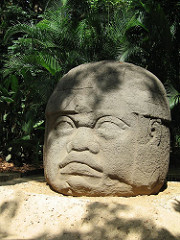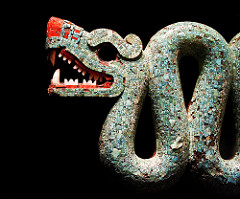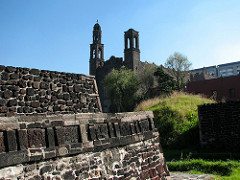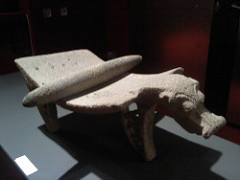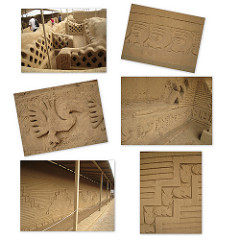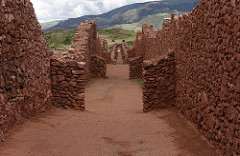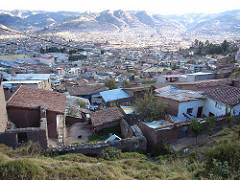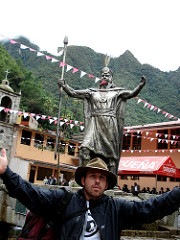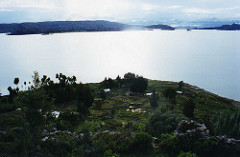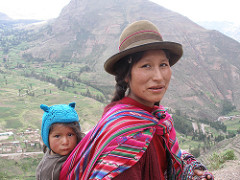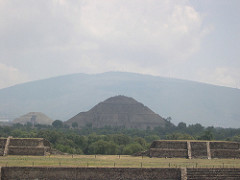Hernan Cortes
Spanish explorer and conquistador who led the conquest of Aztec Mexico in 1519-1521 for Spain. With the help of the Indian allies, he and his followers won. Although the Aztec confederacy put up a stiff resistance, disease, starvation, and battle brought the Tenochtitlan. down in 1521
Pyramid of the sun
Pyramid found in ancient Teotihuacan, it was 200-feet tall and had a base larger than that of the Great Pyramid in Egypt. Located on the Avenue of the Dead
Bernal Diaz del Castillo
Soldier in Cortez's army, wrote the True History of the Conquest of New Spain, a populist history, exalting courage of common soldier. Along with Cortes he greatly admired the Aztec capital of Tenochtitlan.
Tenochtitlan
Capital of the Aztec Empire, located on an island in Lake Texcoco. Its population was about 150,000 on the eve of Spanish conquest. Mexico City was constructed on its ruins.
Lake Texcoco
A lake, now drained, in central Mexico where Mexico City now stands formally the site of the Aztec capital of Tenochtitlan, was connected to the shore by many waterways.
Indians
Columbus believed he had reached the Indies and therefore called the people living there _______.
Teotihuacan
First major metropolis in Mesoamerica, collapsed around 800 CE. It is most remembered for the gigantic "pyramid of the sun".
Tula
The capital city of the Toltec; when it was destroyed, the civilization ended
Toltec Culture
Succeeded Teotihuacan culture in central Mexico; strongly militaristic ethic (set of principles) including human sacrifice; established a capital at Tula about 968;influenced large territory after 1000 C.E.; declined after 1200 C.E. Actually spread as far as Chichen Itza in the Yutacan Peninsula at some point
Topiltzin
Religious leader and reformer of the Toltecs in 10th century; dedicated to god Quetzalcoatl; after losing struggle for power; went into exile in the Yucatan peninsula. disappearance and promised return coincided with the arrival of Cortes
Quetzalcoatl
Aztec nature god, feathered serpent, his disappearance and promised return coincided with the arrival of Cortes
Tlaloc
Major god of Aztecs; associated with fertility and the agricultural cycle; god of rain
Chac
Mayan rain god; appears in the form of a serpent
Chimor
A coastal kingdom; centered on capital of Chan-Chan; emerged as most powerful small state; between 900 and its conquest by the Incas in 1465, gained control of most of north coast of Peru
Chichen Itza
Originally a Mayan city; conquered by Toltecs circa 1000 and ruled by Toltec dynasties; architecture featured pyramid of Feathered Serpent (Quetzacoatl).
Obsidian
A usually black or banded, hard volcanic glass that displays shiny, curved surfaces when fractured and is formed by rapid cooling of lava, was a very important trade thing that was mined in Northern Mexico and maybe traded for Turquoise in the Southwest (Maybe with the Anasazi)
Anasazi
Important culture of what is now the southwest (1000-1300 C.E.). Centered on Chaco Canyon in New Mexico and Mesa Verde in Colorado, they Built multistory residences and worshipped in subterranean buildings called kivas. May have traded with Toltec/ Aztecs/Mayans
Chaco Canyon
An urban center established by Anasazi located in southern New Mexico. There, they built a walled city with dozens of three-story adobe houses with timbered roofs. Community religious functions were carried out in two large circular chambers called kivas.
Mesa Verde
The largest complex of Anasazi cliff-dwellings in the United States Southwest, built between about AD 1150 and AD 1300
kivas
Underground chamber in a pueblo village(especially Anasazi Culture), used by the men especially for ceremonies or councils
Hopewell Culture
Amerindian peoples from Ohio; major part in regional trade, searching for metals, shells, obsidian, manufactured items for their economy and religion, was generally larger and bigger than the other mound building Adena Culture.
Adena Culture
Centered in the Ohio Valley (800B.C. - A.D. 600) left behind enormous earthworks and burial mounds sometimes elaborately shaped like great snakes, birds, or other animals. Also had an elaborate trade network as far as the Gulf and Atlantic.
Cahokia
A large city that were once inhabited by the Mound Builders. It was filled with mounds, which were like graves, Declined in 13th century CE. At hieght had a population of about 30,000 people and contact with parts of Mesoamerica. Located in modern day east ST. Louis with a administrative capital that covered almost 300 acres. Had huge burial mound that was 98 ft tall with a base larger than the Egyptian pyramids. Monk's Mound
Monk's Mound
Largest prehistoric structure in the United States
Covers 16 acres with 4 platforms with ceremonial structure at the top possibly temple of chiefs residence, could be seen through the city
Artifacts at Cahokia (Woodhenge formed by upright timbers that align with solstices and equinoxes, also rebuilt multiple times)
Aztlan
"The place of the white heron" , the supposed home of the Aztecs. Unknown where or if it is real. Most scholars assume that they made up this history to suit their purposes.
Nahuatl
Native Central American people who live(d) in southern Mexico and Central America, including the ancient Aztecs; also, the language spoken by these people
Aztecs
(1200-1521) 1300, they settled in the valley of Mexico. Grew corn. Engaged in frequent warfare to conquer others of the region. Worshiped many gods (polytheistic). Believed the sun god needed human blood to continue his journeys across the sky. Practiced human sacrifices and those sacrificed were captured warriors from other tribes and those who volunteered for the honor. Their capital was Tenochtitlan. They worshipped everything around them especially the sun. Cortes conquered them in 1521.
Pyramid of the Moon
A pyramid complex used for both symbolic functions and the production of military supplies and located at the north end of the Avenue of the Dead in Teotihuacan
Flower Wars
Aztecs, to catch prisoners to use in human sacrifice, to control time and purpose of war was to capture people. (olmecs were before Aztecs, sacrifice was the main reason, felt necessary to "civilize"
Olmec
The first Mesoamerican civilization. Between ca. 1200 and 400 B.C.E., they co created a vibrant civilization that included intensive agriculture, wide-ranging trade, ceremonial centers, and monumental construction. Most remembered for their large stone heads.
Moctezuma 2
1466-1520 Aztec emperor who was the last to reign the Aztec empire before it fell to Spain
Huitzilopochtli
The chief god of the Mexica or Aztec. Originally associated with war, as the empire grew, he became the Sun god and was worshiped throughout Mesoamerica. Aztecs believed he required a steady diet of human hearts.
Nezhualcoyotl
King of Texcoco. Wrote hymns to the "lord of the close vicinity" (an invisible creative force that supported the gods) that survived in oral form until being written down in the 16th century. His poetry wondered about life after death and the existence of the gods. Believed in a monotheistic concept.
Chinampas
Beds of aquatic weeds, mud, and earth placed in frames made of cane and rooted in lakes to create "floating islands"; system of irrigated agriculture utilized by Aztecs
Pochteca
Aztec merchants. Extremely wealthy. Had a huge quantity of material goods etc. But explicitly forbidden to take part in political hierarchy so as not to throw off the balance of power. May have sold at Tlatelolco
Tlatelolco
Originally a separate island city in Lake Texcoco; later incorporated into Tenochtitlan; Market remained the most important in combined city.
Calpulli
7 Clans in Aztec society, later explanded to include residential groups that distributed land and provided labor and warriors
Flowery Death
Death while taking prisoners for the sacrificial knife. It was a fitting end to a noble life and ensured eternity in the highest heaven. (A reward also promised to women who died in childbirth)
Polygamy
This form of marriage was common ONLY among the nobles, and not allowed among the peasants in Aztec society.
metates
a mortar, a ground stone tool used for processing grain and seeds; in traditional Mesoamerican culture,were typically used by women who would grind calcified maize and other organic materials during food preparation, this pointed to a lack of technological sophistication that increasingly defined and limited female Gender Roles.
Florentine Codex
A document that is a major source of information on Aztec history and culture; compiled soon after the spanish conquest of the Aztecs, complied by Fray Bernardino de Shagun in 1550's based on interviews, main source in Nahuatl about the events of the Spanish conquest
Bernardino de Sahagun
Spanish missionary to Aztecs of Mexico, "Florentine Codex", wrote encyclopedia "Father of modern ethnography" (study of culture) and described the effects of smallpox on the Aztecs in, "Seeds of Change."
Seeds of Change
Another name of the Columbian Exchange
The Great Speaker
The ruler of Tenochtitlan that was considered a living god. His court was magnificent and surrounded with elaborate rituals. Those who approached him could not look him in the eyes and were required to throw dirt upon their heads as a sign of humility (humbleness).
Tarascans
A mesoamerican people who were located to the west of the Aztecs., rivals to and subjects of Aztecs, 15th cent
Tlaxcala
Autonomous from Aztec Empire, state of war with Mexica of Tenochtitlan, forced alliance with Spanish, not destroyed after Conquest, under direct protection of Spanish crown after conquest
Great Temple
Temple where priests made sacrafices. One shrine dedicated to Huitzilopochtli, other dedicated to Tlaloc
Twantinsuyu
Word for Inca Empire; region from present-day Colombia to Chile and eastward to northern Argentina
Split Inheritance
Inca practice of descent, all titles and political power went to successor, but wealth and land remained in hands of male descendents for support of cult of dead Inca's mummy, was Major reason that Inca pushed to expand,
Allyus
Incan society lived in a community, or village and family extension
Chan Chan
What was the capital of the Chimor?
Huari
Along with Tihuanaco, large center for regional chiefdoms between 300 and 900 CE; located in southern Peru; featured large ceremonial center supported by extensive irrigated agriculture; established widely diffused religious and artistic symbols spread all over Andean zone
Cuzco
The capital city of the Incan Empire, Located in present-day Peru
Inca
A member of the small group of Quechuan people living in the Cuzco valley in Peru who established hegemony over their neighbors to create the great Inca empire that lasted from about 1100 until the Spanish conquest in the early 1530s
Pachacuti
Ruler of Inca society from 1438 to 1471; launched a series of military campaigns that gave Incas control of the region from Cuzco to the shores of Lake Titicaca called "he who shakes the earth"
Topac Yupanqui
Pachacuti's son and successor from 1471 to 1493; conquered northern coastal kingdom of Chimor by seizing it's irrigation system; extended Inca control into the southern area of what is now Ecuador.
Huayna Capac
the Incan ruler under whom the Incan empire reached its widest extent (died in 1525), onsolidated conquests and suppressed rebellions on the frontier, instead of allowing his oldest son Huascar to succeeed him to the throne, he divided the empire between him and his favorite son, the youngest, Atahualpa which lead to Civil War which led to an easy conquest of them by The Europeans.
Lake Titicaca
The lake between Bolivia and Peru; highest lake in the world on which ships can travel
Sapa Inca
The emperor of the Incan Empire. People believed that he was descended from the sun god.
Quechua
the language of the Inca Empire, now spoken in the Andes highlands, a member of a South American Indian people in Peru who were formerly the ruling class of the Inca empire
Temple of the Sun
Inca religious center located at Cuzco; center of state religion; held mummies of past Incas.
Huacas
holy shrines; mountains, stones, caves, rivers, tombs, temples, etc; places of worship and prayer
Tambos
Way stations used by Incas as inns and storehouses; supply centers for Inca armies on move; relay points for system of runners used to carry messages
Curacas
Ayllu chiefs with privileges of dress and access to resources; community leaders among Andean societies.
Mita
Labor extracted for lands assigned to the state and the religion; all communities were expected to contribute; an essential aspect of Inca imperial control.
Atahualpa
Last Inca ruler who was tricked into a conference by Francisco Pizarro, tried to ransom himself with a hoard of gold, and was executed by garroting. The Spaniards then fought their way to Cuzco and conquered his Empire
Huascar
After Huayna Capac died; there was a civil war between his two sons. He was the older brother and was heir to the throne., fought brother in civil war for leader of Inca, killed shortly before Pizarro's arrival
Inca Socialism
A view created by Spanish authors to describe Inca society as a type of utopia; image of the Inca Empire as a carefully organized system in which every community collectively contributed to the whole.
Garcilaso de la Vega
A Peruvian writer who was the son of a Spanish conquistador and an Inca princess. he wrote accounts of inca life before the Spanish and the Spanish conquest of Peru, and served in Europe as a soldier and established the concept of what is now called "Inca Socialism".
Yanas
A class of people within Inca society removed from their ayllus to serve permanently as servants, artisans, or workers for the inca or the Inca nobility.
Pizzaro
For Spain. led a small army in an invasion of the Inca Empire. He conquered the Inca and gained huge amounts of gold and silver for himself and Spain.
Quipu
An arrangement of knotted strings on a cord, used by the Inca to record numerical information.
Arawaks
Peaceful tribe from the Carribean who were exploited by Columbus for gold and eventually wiped out by war and disease., The first "Indians" so called because they were taught to be residents of India.
Tainos
Also called the Caciques. A people indigenous to the Caribbean, and the largest people living there for a while. They were pretty chill; they were into woodcarving, big houses, hammocks, and ceremonial ballgames instead of war.
Taos
- lived adobe homes
- most significant trading post between the spanish, americans,and indians
- spoke the language of Tiwa
Natchez
Great Sun was their ruler. His advisors were noble men and were chiefs of villages. The Stinkards were peasant farmers. They were a tribe of the Mississippi Valley. Lived past the time of whites. Were warlike, practiced torture as well as sacrifice. Died of European conquest and disease.
Iroquois
A term which designates a confederacy of 5 tribes originally inhabiting the northern part of New York state, consisting of the SENECA, CAYUGA, ONEIDA, ONONDAGA and MOHAWK.
